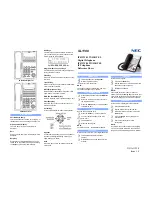
3. TECHNICAL BRIEF
- 5 -
Copyright © 011 LG Electronics. Inc. All right reserved.
Only for training and service purposes
LGE Internal Use Only
The PMIC includes twelve multipurpose pins, eleven that can be configured as digital inputs or outputs, level-
translating bidirectional I/Os, analog multiplexer inputs, or buffered VREF analog outputs. And for the first time,
this PMIC integrates 40 general purpose input/output (GPIO) pins that can be configured as digital inputs or
outputs or level-translating I/Os. Note that the GPIOs are much faster than MPPs for high-speed digital switching.
This mixed signal BiCMOS device is available in the 191-pin nanoscale package (191 NSP) that includes several
ground pins for electrical grounding, mechanical strength, and thermal continuity.
3.9.3 Charging control
The PMIC provides two methods for main battery charging:
A software-controlled method that is identical to previous generations of PM products
An autonomous method – where the PM circuits conduct charging under the direction of a state
machine without software intervention
When using the software-controlled method, the PMIC provides as many as four charging techniques: trickle,
constant current, constant voltage, and pulse. Battery voltage, external supply voltage, and total detected
current measurements are available to software through the on-chip analog multiplexer and HK/XO ADC. This
allows software to monitor charging parameters, make decisions, and control the charging process.
3.9.3.1 Trickle Charging
Trickle charging of the main battery, powered from VDD, is provided by the PMIC. This mode is used to raise a
severely depleted battery’s voltage to a level sufficient to begin fast charging.
Fast charging with a high-current supply should not be attempted on a deeply discharged battery – the battery
would draw excessive current, pull the VDD voltage down, and possibly cause a handset malfunction or
shutdown due to an undervoltage lockout condition. If the PMIC implements current limiting, the excessive
current would combine with the potentially large voltage drop across the charging pass transistor to generate
unwanted heat within the handset as well. To avoid these problems the PMIC provides a constant, low-current
charging mode – trickle charging
















































